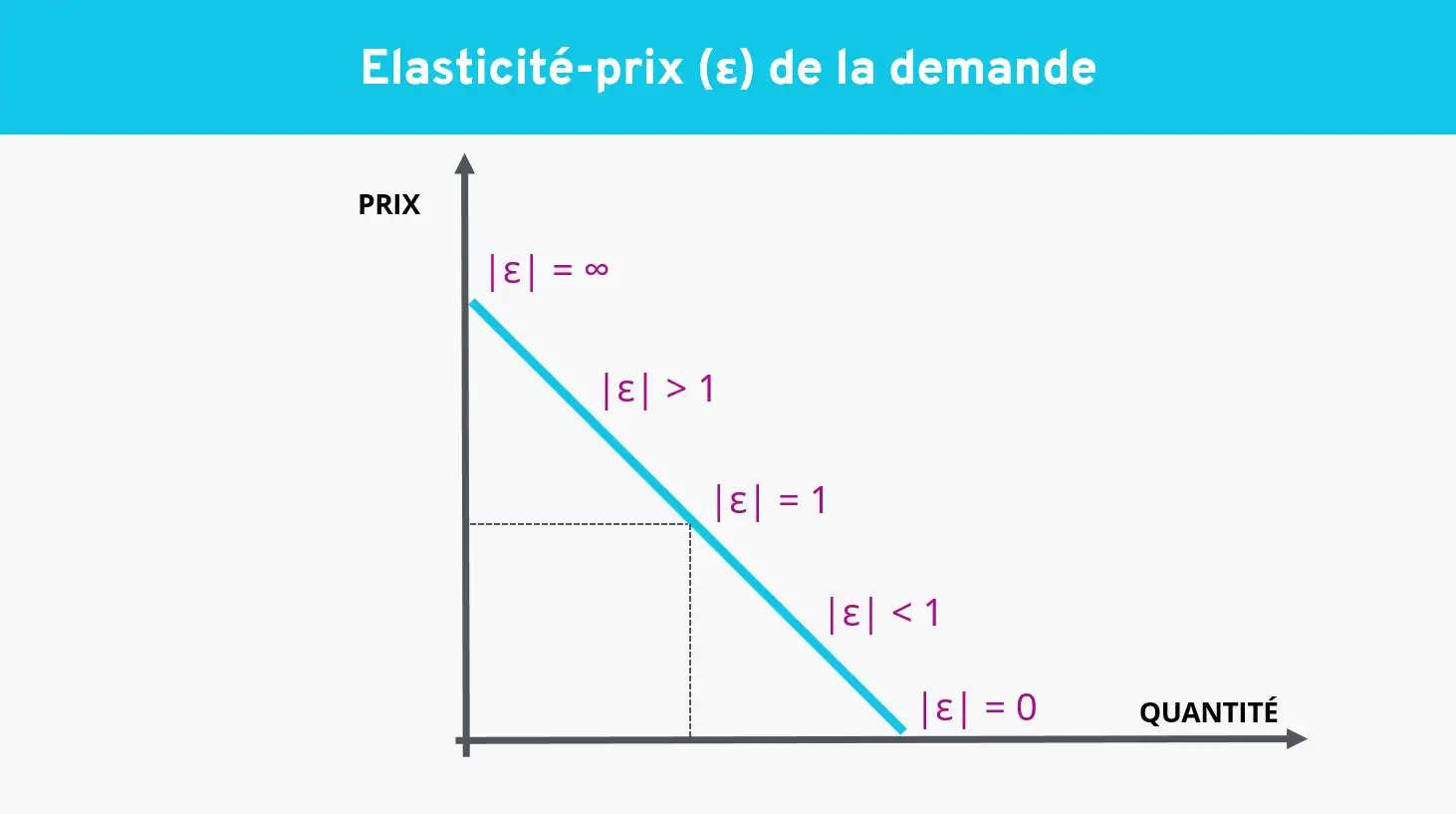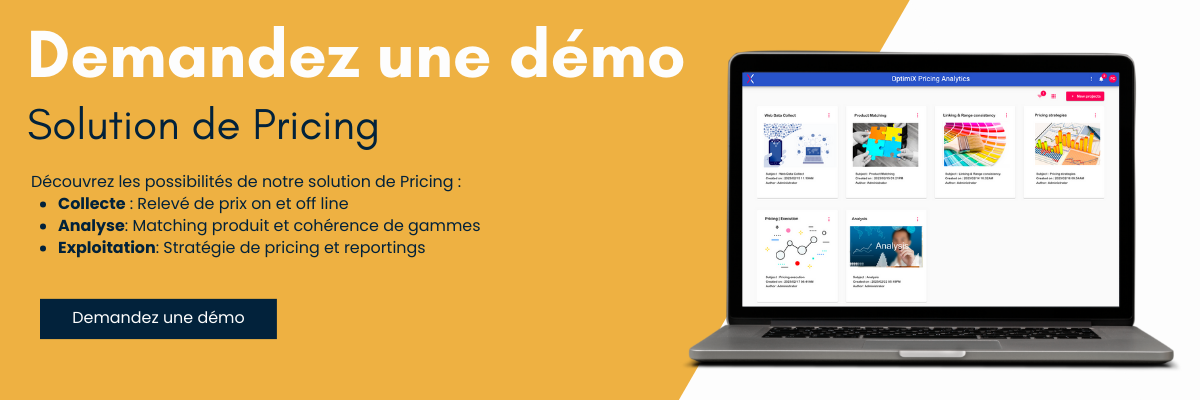Price elasticity: How to optimize your pricing?
The world of retail is constantly evolving. Consumers are increasingly savvy and demanding; retailers must constantly adjust their pricing strategy to remain competitive.
In this context, calculating price elasticity has become an essential tool for retail companies seeking to optimize prices, maximize profits and build customer loyalty.
In this article, we’ll explore what price elasticity is, how to calculate it, and how to use it to make informed pricing decisions in retail.
Understanding Price Elasticity
Price elasticity is an economic concept that measures the sensitivity of demand for a product to a change in its price. In other words, it helps determine how sales of a product react to a change in price.
Price elasticity is usually expressed as a percentage and can be classified into three main categories:
Price elasticity greater than 1 (high price elasticity): In this case, a small change in price results in a proportionately larger change in demand. This means that consumers are very sensitive to price changes, and a price increase will lead to a significant reduction in sales, while a price reduction will stimulate demand.
Price elasticity equal to 1 (unit price elasticity): A change in price leads to a proportional change in demand. This means that total revenue remains constant regardless of the change in price.
Price elasticity less than 1 (low price elasticity): In this case, a change in price results in a proportionately smaller change in demand. Consumers are less sensitive to price changes, which means that sales remain relatively stable despite price changes.
Why is price elasticity important in retail?
Price elasticity is crucial in retail for several reasons:
Profit Maximization: By understanding how price changes influence demand, retailers can adjust their prices to maximize profits. For example, if they discover that their product has low price elasticity, they may consider raising prices slightly without significantly reducing sales.
Inventory management: Price elasticity allows retailers to manage their inventory more efficiently. If a product has high price elasticity, a price reduction may help clear inventory quickly, while a price increase may be considered for products with low price elasticity.
Customer loyalty: A thorough understanding of price elasticity enables retailers to implement pricing strategies that satisfy their customers while maximizing their profit margins. This can help build long-term customer loyalty.

How to calculate price elasticity?
Calculating price elasticity may seem complex, but there is a basic formula you can use:
Price elasticity = (Change in quantity demanded / Initial quantity demanded) / (Change in price / Initial price)
For example, if you sell a product for $100 and reduce the price to $90, resulting in an increase in sales of 10%, you can calculate the price elasticity as follows:
Price elasticity = (0.10 / 1) / (10 / 100) = 1
In this example, the price elasticity is equal to 1, which means that demand is unitary with respect to the price change. It is important to note that price elasticity can vary depending on different factors, such as the product itself, time of year, competition, brand awareness, etc. Therefore, it is often necessary to calculate price elasticity for each product or product group on a regular basis to make accurate pricing decisions.

Using Price Elasticity in Pricing Strategy
Now that you understand how to calculate price elasticity, let’s see how to use it in your retail pricing strategy:
Segment your customer base: Identify customer segments that respond differently to price changes. Some customers may be price sensitive, while others may be more brand loyal or less sensitive to price changes.
Set price targets: Based on your price elasticity analysis, set price targets for each product or product group. If a product has high price elasticity, you might consider price reductions to increase sales. If price elasticity is low, a price increase might be justified.
Monitor the competition: Keep an eye on the prices charged by your competitors. If you discover that your product is more elastic than theirs, this can give you a competitive advantage by adjusting your prices in a more agile way.
Use real-time data: Price elasticity can vary over time depending on different factors. Use real-time data to quickly adjust your prices based on market trends and customer purchasing behaviors.
Test different strategies: Don’t be afraid to experiment with different pricing strategies to see how they affect sales and profit margins. For example, you could try promotional offers, discounts based on quantity purchased, or dynamic pricing based on demand.

How to use elasticity analysis to optimize pricing?
In the retail sector, pricing is an essential component of commercial strategy. Proper pricing can have a significant impact on sales, profitability and customer satisfaction.
One of the most powerful methods for establishing an effective pricing strategy is price elasticity analysis.
Understanding Price Elasticity Analysis
It is essential to understand what it is and why it is crucial for pricing.
Price elasticity analysis is a quantitative method that measures the responsiveness of demand for a product to price changes. It makes it possible to quantify consumers’ sensitivity to pricing changes.
Price elasticity is usually expressed as a coefficient, which can be positive or negative. Here is what different values of price elasticity mean:
Positive price elasticity: An increase in price leads to a decrease in demand. This means that consumers are sensitive to price increases, and a reduction in demand can be observed when prices increase.
Negative price elasticity: An increase in price leads to an increase in demand. This situation is less common, but it can occur in the case of luxury goods or Giffen goods.
Zero price elasticity: A change in price does not affect demand. In this case, revenue remains constant, regardless of price changes. This corresponds to unit price elasticity.
Steps to Using Price Elasticity Analysis
Now that we have a basic understanding of price elasticity analysis, let’s look at how to use it to optimize pricing in retail:
Step 1: Data collect
The first step is to collect data on product sales and price changes. It is essential to have a complete data set for a significant period of time. The more precise and detailed the data, the better conclusions you can draw.
Step 2: Calculation of price elasticity
Once you have the data, you can calculate the price elasticity for each product or group of products. Use the formula mentioned previously to obtain the price elasticity coefficients. You can also use data analysis tools and software to make this process easier.
Step 3: Interpreting the results
Once you have calculated price elasticity, analyze the results. Identify products with high price elasticity, meaning that a small change in price results in a significant change in demand. Likewise, look for products with low price elasticity, which indicates that demand remains relatively stable despite price changes.
Step 4: Define pricing strategy
Based on the results of the price elasticity analysis, define your pricing strategy. Here are some possible approaches:
High Price Optimization: For products with low price elasticity, consider raising prices to increase profit margins without sacrificing sales.
Low pricing strategy: For products with high price elasticity, consider price reductions to stimulate demand. This can be particularly effective for clearing inventory.
Dynamic pricing: Use real-time data to adjust prices based on demand and competition. You can also implement differentiated pricing based on customer segmentation.
Promotional Offers: Use price elasticity analysis to determine the most suitable products for promotions. This can help you maximize sales during promotional periods while maintaining your profit margins.
Step 5: Monitoring and Adjustment
An effective pricing strategy doesn’t stop at a single price elasticity analysis. It is essential to constantly monitor sales, competitive prices and consumer reactions. Adjust your strategy according to market developments and customer purchasing behavior.

The Benefits of Price Elasticity Analysis
Price elasticity analysis offers many benefits for retailers:
Optimizing profits: By understanding consumers’ price sensitivity, you can adjust your prices to maximize profits.
Better inventory management: You can use price elasticity analysis to quickly clear overstocked products or to maintain stable prices for high-demand products.
Customer loyalty: By offering pricing tailored to customer sensitivity, you can build customer loyalty and improve satisfaction.
Market Responsiveness: You can quickly adjust your prices based on market trends and competition, giving you a competitive advantage.
Challenges of analyzing price elasticity
Although price elasticity analysis is a powerful tool, it also comes with challenges:
Accurate Data Collection: It is essential to have reliable sales and pricing data to perform accurate analysis.
Understanding External Factors: Price elasticity can vary depending on external factors such as seasonality, market trends, competition, etc. It is important to take these factors into account in the analysis.
Continuous Analysis: Price elasticity analysis should be an ongoing process. Market conditions are constantly changing, and an effective pricing strategy requires continued responsiveness.
How to use elasticity analysis to optimize pricing taking into account customer perceived value
In the world of retail, pricing is a subtle art that requires a deep understanding of customer preferences. Price elasticity analysis, as we explored in the previous article, is a powerful tool for informing pricing decisions.
However, another essential dimension in the pricing strategy is taking into account the value perceived by the customer.
Customer perceived value: a key element of pricing

Customer perceived value represents a customer’s subjective perception of the value of a product or service. It is often influenced by various factors such as perceived quality, brand, purchasing experience, product features, etc. Understanding how customers perceive a product’s value is essential to determining how they will respond to price changes.
Link between perceived value and price elasticity
Customer perceived value and price elasticity are closely related. Indeed, the perception of the value of a product can influence a customer’s sensitivity to price changes.
Here’s how these two concepts intertwine:
High-end products and low price elasticity: High-quality products, often perceived to offer higher value, tend to have lower price elasticity. Customers are willing to pay a higher price for what they view as higher quality.
Commodity Products and High Price Elasticity: Conversely, commodity or generic products tend to have higher price elasticity. Customers view these products as interchangeable, meaning they are more sensitive to price changes.
Customer experience and price elasticity: Shopping experience, customer service and other factors related to perceived value can also influence price elasticity. Customers who have a positive experience may be less sensitive to price changes because they assign a high value to the entire purchasing experience.
Step 1: Understand customer perceived value
The first step to incorporating customer perceived value into price elasticity analysis is to understand how customers perceive the value of your products. This requires extensive research, including customer surveys, data analysis and market research.
Ask yourself questions like:
- What factors are most important to our customers when evaluating the value of a product?
- How do our products compare to those of the competition in terms of perceived quality, features, and purchasing experience?
- What features or benefits of our products are most appreciated by our customers?
Step 2: Assess price elasticity based on perceived value
Once you have a clear understanding of customer perceived value, use this information to assess the price elasticity of your products. Here are some possible approaches:
Customer Segmentation: Use customer segmentation based on perceived value. You may have customer segments willing to pay more for higher value, and others who are more price sensitive.
Tiered Pricing: Based on customer perceived value, consider tiered pricing. Customers who place high value on your products might be willing to pay more, while you might adopt a more competitive pricing strategy for products where the perceived value is lower.
Marketing communications: Highlight features and benefits that match customer perceived value. Marketing campaigns can influence the perception of value and, therefore, price elasticity.
Step 3: Continuously monitor and adjust
Taking customer perceived value into account in price elasticity analysis is an ongoing process. It is essential to continuously monitor customer feedback, market trends and the performance of your products.
Adjust your prices and pricing strategy based on changes in customer perceived value. If you find that perceived value is decreasing, it may be necessary to review your pricing to maintain competitiveness.
Benefits of considering perceived value
Integrating the value perceived by the customer into the analysis of price elasticity offers several advantages:
Pricing Optimization: You can adjust your prices to reflect customer-perceived value, maximizing your profit margins.
Better customer retention: By meeting your customers’ expectations for value, you can build customer loyalty and encourage repeat purchases.
Strategic positioning: You can position your products as offering superior value compared to the competition, which can give you a competitive advantage.
Build a consistent pricing policy to stimulate sales

Understanding Price Consistency
Price consistency does not simply mean maintaining stable prices. It encompasses a holistic view of pricing, taking into account different factors such as branding, customer perception of value, competition and price elasticity analysis.
Here’s why price consistency is essential:
Building Trust: Customers need predictability. Consistent pricing builds customer trust, enticing them to return.
Simplicity for customers: A consistent pricing policy simplifies the purchasing process for customers. They know what to expect, which makes the experience more enjoyable.
Avoid confusion: Fluctuating or conflicting prices can cause confusion among customers. A consistent pricing policy avoids this confusion.
Improved retention: When customers know they’re getting consistent value, they’re more likely to stay loyal to your brand.
Step 1: Understand your market and customer base
The first step to building a consistent pricing policy is to deeply understand your market and your customer base. Here are some key aspects to consider:
Competition analysis
- Who are your main competitors?
- How are they positioned in terms of pricing?
- What are their advantages and disadvantages compared to your products?
Understanding customer needs
- What are your customers’ main price expectations and preferences?
- How do they perceive the value of your products compared to those of the competition?
- What customer segments are you targeting, and how do they react to price changes?
Demand assessment
- How does demand respond to specific price changes (price elasticity analysis)?
- Which products or services are most sensitive to price variations?
- Where do the tiered pricing opportunities lie?
Step 2: Define a pricing strategy
Once you understand your market and customer base, it’s time to define a pricing strategy. This strategy should reflect your business objectives, market positioning and customer perception of value. Here are some pricing strategies commonly used in retail:
Pricing compared to the competition
Offer prices similar to those of the competition to remain competitive.
Use competitively aligned pricing as a starting point, then adjust based on factors specific to your business.
Value Pricing
Emphasize quality and perceived value to justify higher prices.
Use value pricing for premium products or premium positioning.
Dynamic pricing
Adjust prices based on demand, seasonality or other factors in real time.
Use data analysis tools to continuously optimize prices.
Tiered pricing
Offer different pricing options for different levels of service or quality.
Allow customers to choose the level that best suits their needs.
Promotional pricing
Use promotions, discounts and special offers to drive short-term sales.
Ensure promotions are in line with the overall pricing strategy.
Step 3: Implement Consistent Pricing
Once you have your pricing strategy figured out, it’s time to implement it consistently. This means aligning your pricing with your strategy at every level of the business, from pricing planning to customer communication.
Develop tools and guidelines
Create clear pricing guidelines for your team.
Develop tools and models to help determine pricing consistently.
Staff training
Train your staff on pricing strategy and associated guidelines.
Make sure your team understands how to effectively communicate the value of your products to customers.
Transparent communication with customers
Clearly communicate your prices and added value to customers.
Be transparent about price changes, promotions and the reasons behind them.
Step 4: Continuously monitor and adjust
Consistent pricing does not mean that prices remain fixed. It’s essential to continually monitor your pricing performance and adjust accordingly. Here are some recommended practices for monitoring and adjusting:
Price elasticity analysis
Use price elasticity analysis to assess demand response to price changes.
Identify opportunities for price adjustments to maximize sales or profit margins.
Competitor monitoring
Monitor competitive price changes and adjust your pricing accordingly.
Be responsive to market and competitive changes.
Evaluation of performances
Use key performance indicators (KPIs) to track sales, profit margins and customer satisfaction.
Analyze data to identify trends and opportunities for improvement.
Conclusion
Price elasticity is a powerful tool for optimizing pricing in retail. By understanding how price changes influence demand, retailers can make informed decisions to maximize profits, manage inventory efficiently and build customer loyalty. It is essential to calculate price elasticity regularly to adapt to market developments and consumer behavior. Finally, a well-thought-out pricing strategy can be the difference between success and failure in the competitive world of retail.
Price elasticity analysis is an essential tool for optimizing retail pricing. By understanding how price changes influence demand, retailers can make informed decisions to maximize profits, manage inventory effectively, build customer loyalty, and stay competitive in the ever-changing marketplace. Although price elasticity analysis presents challenges, the benefits it offers in terms of profitability and competitive advantage are well worth the effort. Ultimately, using this analysis wisely can significantly contribute to the success of a retail business.
Price elasticity analysis is a valuable tool for optimizing retail pricing. When complemented by consideration of customer perceived value, it becomes even more powerful. By understanding how customers perceive the value of your products and adjusting your prices accordingly, you can maximize profits, build customer loyalty, and stay competitive in an ever-changing marketplace. The combination of these two approaches provides a fine balance between profitability and customer satisfaction, contributing to the continued success of your retail business.
Building a consistent pricing policy is an essential element of retail pricing strategy. By understanding your market, your customer base and defining a suitable pricing strategy, you can create a positive shopping experience, maximize profits and strengthen customer loyalty. However, this requires continuous analysis, responsiveness to market changes and effective management of customer expectations. Ultimately, a consistent pricing policy can play a key role in the growth and continued success of your retail business.


